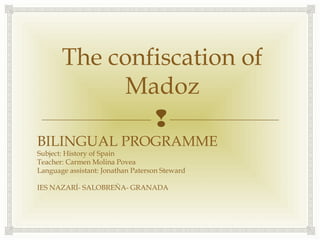
Confiscation of Madoz
- 1. The confiscation of Madoz BILINGUAL PROGRAMME Subject: History of Spain Teacher: Carmen Molina Povea Language assistant: Jonathan Paterson Steward IES NAZARÍ- SALOBREÑA- GRANADA
- 3. The confiscation of Madoz 1855 During the Bienio progresista (at the forefront of which was again Baldomero Espartero, along with O'Donnell) the Treasury Minister Pascual Madoz carried out a new confiscation in 1855, executed with greater control than the Mendizábal. It declared for sale all properties of the State, the clergy, the Military Orders (Santiago, Alcántara, Calatrava, Montesa and St. John of Jerusalem), confraternities, pious works, sanctuaries or shrines, of the former Infante Don Carlos, of the bienes de propios (properties owned by a City Hall to provide a rent at the same for be leased) and of the commons of the people, of the charity and of the public instruction, with the exceptions of the Pious Schools and the hospitals of Saint John of God, dedicated to education and medical care respectively, since they reduced the government spending in these areas. Likewise were allowed the confiscation of the censuses belonging to the same organizations.
- 4. This was the confiscation which achieved greater sales volume and had a higher importance than all previous. However, the historians have traditionally been much more occupied towards that of the Mendizábal, whose importance lies in its duration, the large volume of mobilized goods and the large repercussions that it had in the Spanish society.[15] Having been the subject of confrontation between conservatives and liberals, there came a time when all political parties recognized the need to rescue those idle assets in order to incorporate to the higher economic development of the country. Was suspended the application of the law on 14 October 1856 and resumed two years later, on 2 October 1858, being O'Donnell president of the Council of Ministers. The changes of government did not affect the auctions, which continued until the end of the century. In 1867 it sold a total of 198 523 rural properties and 27 442 urban. The state entered 7 856 000 000 reales between 1855 and 1895, almost twice that obtained with the confiscation of Mendizábal. This money was mainly spent to cover the State budget deficit, public debt repayment and public works, reserving 30 million reales per year for "reconstruction and repair of some churches of Spain".
- 5. Traditionally this period has been called a civil confiscation, a misnomer, because if it is true that there were auctioned a large number of farms that had been the common property of the people, which was a novelty,there were also sold many goods until then belonging to the Church, especially those which were in the possession of the secular clergy, but that was, in short, a very serious abuse and looting of the goods of the rural people, farmers, who depended heavily on them and condemned millions to emigration and proletarianization in cities. Overall, it is estimated that of all that was sold off, 35% belonged to the church, 15% to charity and 50% were municipal properties, mainly peoples or towns. The Municipal Statute by José Calvo Sotelo of 1924 finally repealed the laws on confiscation of property of the people and thus the confiscation of Madoz. Source:https://ipfs.io/ipfs/QmXoypizjW3WknFiJnKLwHCnL72vedxjQkDDP1mXWo6uco/wiki/Spanish_confiscation.html
- 6. QUESTIONS 1.- During which period did the confiscation occur? 2.- Who was responsible for the confiscation? 3.- What did the confiscation involve? 4.- What did the confiscation achieve? 5.- How was the money raised spent? 6.- How was this period traditionally called? 7.- During the confiscation many properties were sold off. Who did these properties originally belong to, and how much did each group or institution own?
- 7. QUESTIONS 1.- During which period did the confiscation occur? 2.- Who was responsible for the confiscation? 3.- What did the confiscation involve? 4.- What did the confiscation achieve? 5.- How was the money raised spent? 6.- How was this period traditionally called? 7.- During the confiscation many properties were sold off. Who did these properties originally belong to, and how much did each group or institution own?